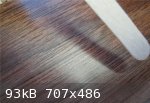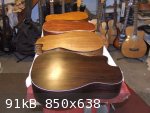jdowning
Oud Junkie
    
Posts: 3485
Registered: 8-2-2006
Location: Ontario, Canada
Member Is Offline
Mood: No Mood
|
|
Make Your Own 'Tru-Oil' Varnish
Traditionally oil varnishes were used on the bowls of lutes, violins and other musical instruments (such as ouds?).
Oil varnish is basically made by heating linseed oil and softwood resins so that they combine together and then allowing the raw varnish to oxidise in
sunlight for several months before use. Making an oil varnish suitable for instrument work is tricky and hazardous - the materials being highly
combustible when heated. Oil varnish also requires some skill in its application by brush.
A popular alternative today is to use a so called 'hand rubbed' oil/varnish finish - an attractive semi-gloss finish that is easy to apply. Such
finishes are generally known as 'Danish Oil' varnishes of which 'Tru-Oil' is a popular example.
Unlike making an oil varnish 'from scratch', a 'Danish Oil' is quickly and easily prepared by simply mixing together, in the correct proportions,
materials readily available from local hardware stores or paint suppliers.
The components of a 'Danish Oil' varnish are Boiled (not raw) Linseed Oil and an oil based varnish all diluted to a desired 'watery' consistency with
a paint thinner. Polymerised (not raw) Tung oil may be used in place of Linseed Oil and the thinners may either mineral spirit or pure Turpentine.
'Tru-Oil' is made from a mixture of 56% mineral paint thinners, 33% oil varnish and 11% linseed or Tung oil. The exact specification of the components
are, of course, a trade secret.
The proportions of a 'Danish Oil' may be varied - the more varnish the quicker the drying time and the greater the dilution with thinners the more
coats that are required to build a finish.
For these trials the same proportions as 'Tru-Oil' were used with a mixture of Boiled Linseed Oil, an indoor Polyurethane varnish and pure Turpentine.
The test piece was quarter sawn Black Walnut - fairly opened grained - planed smooth but with no grain filler applied.
Each varnish coat was brushed on so that the surface was saturated. After drying for about 10 to 20 minutes any surplus varnish remaining on the
surface was wiped off with a paper towel - wiping across the grain (important!).
After drying for 24 hours the surface was lightly sanded - in the direction of the grain (important!) - with a 'Norton' 3X 320 grit open grained
paper. The varnish dust created fills the wood grain. The next coat is then applied - brushing across the grain (important!) - and is allowed to dry
for 10 to 20 minutes before all surplus varnish is wiped off - again across the grain.
After drying for 24 hours this process is repeated and eventually results in the wood grain being completely filled - in this case after about six
coats.
The final finish is smooth and hard, very easy to apply with good penetration, and with a semi gloss lustre bringing out the pattern of the wood grain
to good effect.



|
|
|
SamirCanada
Moderator
     
Posts: 3405
Registered: 6-4-2004
Member Is Offline
|
|
thanks for the info John,
I will try this recipe. seems like its easy enough to apply too.
@samiroud Instagram
samiroudmaker@gmail.com
|
|
|
jdowning
Oud Junkie
    
Posts: 3485
Registered: 8-2-2006
Location: Ontario, Canada
Member Is Offline
Mood: No Mood
|
|
Good luck Samir.
I have re-checked the article in "Fine Woodworking" - 'Oil/Varnish Finishes - experiment to find the right proportions' by Don Newell and would add
the following comments for those who are interested in mixing their own oil/varnish finish.
Substituting Polymerised Tung oil for Linseed oil produces a varnish/oil mixture that dries faster (3X). It also produces a much harder finish than a
varnish/linseed oil mix.
Newell did not test a diluted oil/varnish so some experimentation with the proportion of thinner (mineral spirit or turpentine) might be worth testing
to find the best 'hand rubbing' consistency. Less dilution = fewer coats.
Polymerised Tung oil is available from Lee Valley Tools of Ottawa. They also stock 'Norton 3X' abrasive paper ("sand paper") - an excellent, fast
cutting, non clogging and durable abrasive paper in grits from coarse 60X to fine 400X.
|
|
|
Marina
Oud Junkie
    
Posts: 615
Registered: 9-1-2005
Location: Bosnia
Member Is Offline
Mood: Enthusiastic
|
|
Hello there!
I got very nice cheep student model Turkish oud and I lent it to one student. I thought, maybe it would be a good idea to put some varnish on the top
of the oud to protect it from dirt. There is no issue of the sound because it is a basic model, just estetic. What kind of varnish do you suggest?
Thanx

|
|
|
jdowning
Oud Junkie
    
Posts: 3485
Registered: 8-2-2006
Location: Ontario, Canada
Member Is Offline
Mood: No Mood
|
|
Hi Marina
Turkish ouds traditionally have the tops left unvarnished. I would leave the face unvarnished as intended by the maker.
|
|
|
Yaron Naor
Oud Junkie
    
Posts: 275
Registered: 1-24-2009
Location: Bat Hefer, Israel
Member Is Offline
Mood: Happy
|
|
One coat
Quote: Originally posted by Marina  | Hello there!
I got very nice cheep student model Turkish oud and I lent it to one student. I thought, maybe it would be a good idea to put some varnish on the top
of the oud to protect it from dirt. There is no issue of the sound because it is a basic model, just estetic. What kind of varnish do you suggest?
Thanx

|
Hi Marina, one coat of shellac will do the work!
I did it on some ouds and it protects the soundboard from dirt
See the image of a 4 years old oud and still clean.
Good luck
Yaron.

|
|
|
jdowning
Oud Junkie
    
Posts: 3485
Registered: 8-2-2006
Location: Ontario, Canada
Member Is Offline
Mood: No Mood
|
|
..... and 'no varnish' includes shellac!
|
|
|
bulerias1981
Oud Junkie
    
Posts: 770
Registered: 4-26-2009
Location: Beacon, NY
Member Is Offline
Mood: John Vergara Luthier Lord of the Strings instrument making and repair
|
|
jdowning,
What was the recipe for the application used on the scrap wood sample?
Also, you say you brushed on "saturated" layers onto the wood. I assume this means thick, liberal amounts. You then add that you wiped this with a
paper towel. Is this what filles the open grain?
Wouldn't particles from the paper towel become imbedded into the varnish?
|
|
|
jdowning
Oud Junkie
    
Posts: 3485
Registered: 8-2-2006
Location: Ontario, Canada
Member Is Offline
Mood: No Mood
|
|
The same proportions as the commercial 'Tru-Oil' as noted in the first post.
Yes - the whole surface of the test piece was flooded with the varnish - liberal amounts. The varnish is a thin 'watery' consistency when applied.
No - it is the fine varnish dust, after sanding along the grain direction, that fills the pores of the wood - see the image in the first post.
No - particles from the paper towel did not become embedded in the varnish or the wood pores. The surplus varnish seen remaining on the surface of the
wood is still quite fluid when wiped off after 10 or 20 minutes. The varnish on the surface should not be allowed to dry until it becomes 'tacky' or
sticky before being wiped off (across the grain).
|
|
|
billkilpatrick
Oud Junkie
    
Posts: 563
Registered: 1-3-2004
Location: italy
Member Is Offline
Mood: what?
|
|
thank you john - i read about "tru-oil" years ago but import/export nightmares there are a plenty here in italy and it remained out-of-bounds - you've
saved the day! - grazie!.
|
|
|
jdowning
Oud Junkie
    
Posts: 3485
Registered: 8-2-2006
Location: Ontario, Canada
Member Is Offline
Mood: No Mood
|
|
Glad the information is of some use Bill.
Don't forget to experiment a bit with small quantities of the materials that you can obtain in Italy until you find the mixture that best suites your
requirements (determined on test pieces of wood) - Don Newell suggests a 50% oil/ 50% varnish as a good starting point before diluting with a thinner.
Use only oil based varnishes - not modern water based varnishes.
Some say that the commercial 'Tru-Oil' formula substitutes polymerised Tung oil in place of Boiled Linseed oil making the mixture faster drying and
with harder finish.
My test mix using Linseed oil dried within 24 hours (so that abrading the surface with fine sandpaper did not 'clog' the paper). I have no way of
testing the relative hardness of a varnish but the test surface seemed hard enough (not soft to the touch).
Possibly the 'ancients' - at least from the 15th C - also mixed their own version of "Tru-Oil" varnish (no evidence for that but the ingredients -
Linseed Oil, Oil Varnish and Turpentine were available to them - not sure about Tung Oil).
|
|
|
billkilpatrick
Oud Junkie
    
Posts: 563
Registered: 1-3-2004
Location: italy
Member Is Offline
Mood: what?
|
|
... and if "the red violin" is anything to go by ... the ancients also used blood-of-the-beloved.
|
|
|
freya
Oud Junkie
    
Posts: 276
Registered: 2-8-2004
Location: Asheville NC
Member Is Offline
Mood: Happy in the mountains of WNC
|
|
I'd second what John says about not diluting until you evaluate the consistency for your own needs. Even the 50/50 mix seems a lot thinner than the
tru-oil I have, but I've had the tru-oil around for a while so it may have thickened up...
Also, it had been a long time since I've used turp for anything and I had forgotten just how bad the vapors are.
In any case, I mixed up a quart and am working through the application process on Indian Rosewood, Ovankol, Figured Bubinga, and Honduran Mahogany.
The Bubinga, even though I did do one grain fill with Timbermate, is going to need _a lot_ of coats. I've attached a picture of things in progress and
will post again when I'm done (or can't take the turps anymore).
Long term, I think I'm going to try to move entirely to food-safe finishes (or at least as close to to 0 VOC as possible) but that will be another
thread.

|
|
|
jdowning
Oud Junkie
    
Posts: 3485
Registered: 8-2-2006
Location: Ontario, Canada
Member Is Offline
Mood: No Mood
|
|
Nice work freya.
I would differentiate between 'turps' a petroleum distillate paint solvent and 'turpentine' is a paint solvent distilled from softwood resins such as
Pine or Larch. Turps smells bad but turpentine smells aromatic, however, avoid breathing the fumes of either of them.
I used turpentine for my mix.
|
|
|